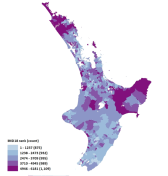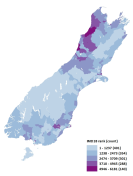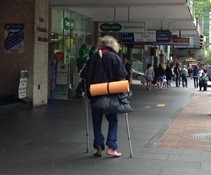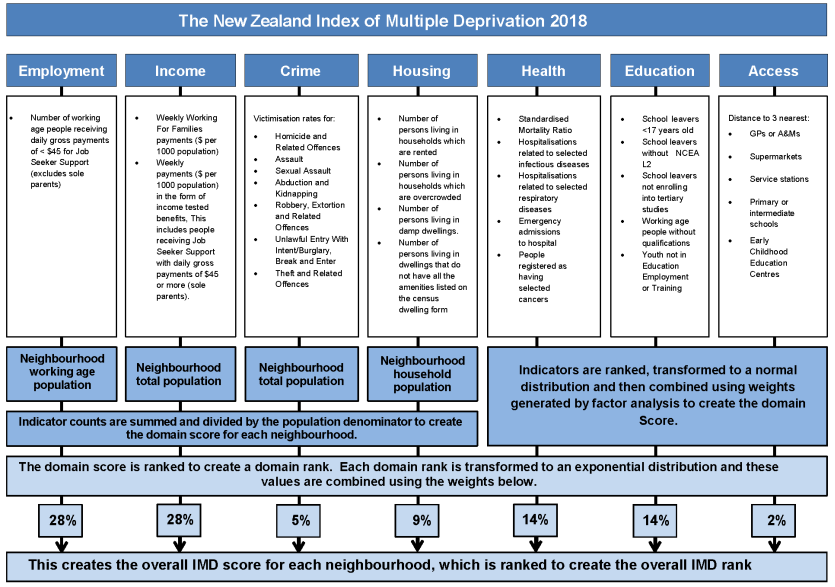School of Population Health
Deprivation and Health Geography within NZ
2018 New Zealand Index of Multiple Deprivation (IMD18)




We are pleased to launch the 2018 version of the New Zealand Index of Multiple Deprivation (IMD18)
2018 Index of Multiple Deprivation
The 2018 New Zealand Index of Multiple Deprivation (IMD18) is a set of tools for identifying concentrations of deprivation in New Zealand. The IMD18 comprises 29 indicators grouped into seven domains of deprivation: Employment, Income, Crime, Housing, Health, Education and Access to services. IMD18 is the combination of these seven domains, which may be used individually or combined. The same methods used for IMD13 were used in 2018, however, we added two indicators (household dampness and household amenities) to the Housing Domain. Figure 1 shows the 2018 IMD’s 29 indicators and seven domains. The 2018 New Zealand Index of Multiple Deprivation was funded by the Auckland Medical Research Foundation.
IMD18 measures deprivation at the neighbourhood level in custom-designed 2018 data zones that have an average population of 761. Data zones are designed to produce better small area information without losing their contents to suppression or confidentiality. The New Zealand land mass was divided into 6,181 data zones (DZ) in 2018, which mostly nest within 2013 data zone boundaries. Some of the 2013 data zones had low populations in 2018, so were merged with adjacent areas, while those areas that experienced a population increase between 2013 and 2018 were split to maintain relatively consistent populations. No 2018 meshblocks were split. Combining was not possible for 49 data zones with very low populations (ranging from 399 to 499) due to unsuitable neighbouring data zones, and splitting was not possible for 2 data zones with very high populations (1272 and 1284). On average, there are 8.55 meshblocks per data zone.
Figure 1. Developing the 2018 NZ Index of Multiple Deprivation: An overview of indicators, domains and weights. Adapted from Figure 4.2 SIMD 2012 Methodology, in Scottish Index of Multiple Deprivation 2012. Edinburgh: Scottish Government (Crown copyright 2012).
The IMD provides a richer, more nuanced view of area level deprivation in New Zealand. Our vision is for the IMD and the data zones to be widely used for community advocacy, research, policy and resource allocation, providing a better measurement of area deprivation in New Zealand, improved outcomes for Māori, equity of service provision, and a more consistent approach to reporting and monitoring the social climate of New Zealand.
Our team
The 2018 Index of Multiple Deprivation was developed by the IMD team: Dr Daniel John Exeter, Dr Arier Chi Lun Lee, Dr Jinfeng Zhao, Dr Sue Crengle, Annie Chiang and Michael Browne, with help and support from numerous individuals and organisations.
IMD18 data sets
2018 New Zealand Index of Multiple Deprivation spreadsheet: IMD18 (1.3 MB, MS Excel)
Downloadable spreadsheet of IMD18 with the 2018 usual resident population (URP) of data zones, four geographic boundary types, overall deprivation and seven separate domains. There are also seven versions of the index with one domain removed to avoid circularity in analyses that focus on one of the domains.
- 2018 New Zealand Index of Multiple Deprivation shapefile: IMD18 (61 MB, ArcGIS shapefile)
Downloadable ArcGIS shapefile of IMD18 with the 2018 usual resident population (URP) of data zones, four geographic boundary types, overall deprivation and seven separate domains. There are also seven versions of the index with one domain removed to avoid circularity in analyses that focus on one of the domains. The zip file includes two ArcGIS layer files that allow users to reproduce the colour ramp used in the online interactive maps of the IMD.
Interactive maps of deprivation in New Zealand in 2018
Use interactive maps to zoom into an area of interest to see its deprivation profile, filter by a particular level of deprivation, compare neighbourhoods or explore different dimensions of deprivation.
New Zealand Data Zones 2018
Information about New Zealand Data Zones 2018 and downloads are available here.
Deprivation maps of 20 DHB areas using the IMD18
Maps of deprivation in the 20 District Health Board areas showing the geographic distribution of overall IMD18 deprivation as well as the distribution of seven domains of deprivation: Employment, Income, Crime, Housing, Health, Education and Access to services.
Geocoding addresses and generating deprivation profiles for selected geographic areas using IMD18
An advanced interactive map allows you to geocode single addresses or batches of addresses and generates a deprivation profile for selected geographic areas (e.g. Mt Albert GED, Thames-Coromandel District, Southland DHB, Canterbury Region) using IMD18 and its seven domains. You can also use this map to search on a single address (e.g. your home address).
Reports and publications
A brief report on development of the 2018 New Zealand Index of Multiple Deprivation (IMD18) (2.4 MB, PDF)
-
The New Zealand Indices of Multiple Deprivation: a new suite of indicators for social and health research in Aotearoa, New Zealand is a 2017 article in the PLOS ONE journal about the development of the NZIMD and NZ data zones.
-
Developing intermediate zones for analysing the social geography of Auckland, New Zealand is a 2016 article describing the creation of two new geographical boundary files known respectively as lower zones and upper zones for investigating social phenomena and visualising disparities in health outcomes in the Auckland Region. The same methodology was used to develop 5958 data zones for the whole of New Zealand.
The research team are grateful to the Health Research Council of New Zealand for funding the original research project (IMD13), and to the Auckland Medical Research Foundation for funding the 2018 update. This research would not have been possible without the provision of data, expert guidance and support of many individuals and the following organisations: Accident Compensation Corporation, Action on Smoking and Health, Aotearoa People's Network Kaharoa, ANZ Bank, ASB Bank, Association of Public Library Managers Inc. Auckland City Hospital, Auckland Uniservices Ltd, Auckland University of Technology, Beacon Pathway, BNZ Bank, BRANZ, Bishop's Action Foundation, Canterbury District Health Board, Child Poverty Action Group, COMET Auckland, Counties-Manukau DHB, Department of Corrections, Energy Efficiency and Conservation Association, Family Start, Federated Farmers, Heart Foundation, Housing New Zealand Corporation, Inland Revenue, Kiwibank, Leeds University, Maritime NZ, Massey University, Ministries of Business, Innovation and Employment, Education, Health, Justice and Social Development, National Collective of Independent Women’s Refuges, Ngāti Whātua o Ōrākei, North Shore Hospital, Northland DHB, New Zealand Certified Builders Association, NZ Fire Service, nzchurchnet.co.nz, NZ-Libs, NZ Police, NZ Post, NZ Racing Board, NZ Transport Agency, Royal New Zealand College of General Practitioners, Ollivier & Company, Otago University, Participants in the Feb 2014 and Feb 2017 hui, Pharmac, Plunket, Prisoners Aid and Rehabilitation Trust, Problem Gambling Foundation, Salvation Army, St John's Ambulance, Southern African Social Policy Research Institute, Statistics New Zealand, TSB Bank, Tairāwhiti DHB, Te Kāhui Mana Ririki Trust, Te Kupenga Hauora Māori, Te Matapihi he tirohanga mō te iwi Trust (National Maori Housing Trust), Te Rūnanga o Ngāti Hine, Te Wānanga o Aotearoa, Te Whānau O Waipareira Trust, Telco2 Ltd, Tenancy Tribunal, University of Auckland, University of Canterbury, University of Otago, University of Oxford, Waikato University, Waitemata DHB, Wellington Free Ambulance, Westpac Bank, and Woopa Design.





